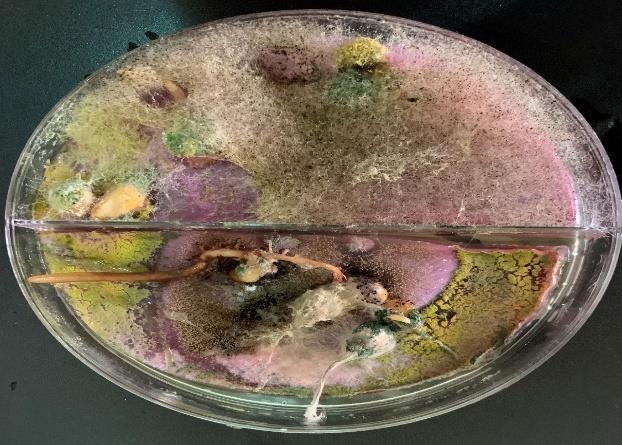Studying Toxigenic Fungi and Mycotoxins Detection from Bean (Phaseolus vulgaris L) in Duhok Province/Kurdistan of Iraq.
DOI:
https://doi.org/10.21271/ZJPAS.35.4.19Keywords:
Toxigenic fungi, Phaseolus, Beans, Aflatoxins; Ochratoxin A; TrichothecensAbstract
The common bean (Phaseolus vulgaris L.) is one of the most widely farmed legumes, with farmers cultivating a variety of cultivar variants in Kurdistan of Iraq. Total of 50 bean samples were tested to establish their mycological contamination and their toxigenic potential under certain conditions, a variety of fungi may develop within bean grains; some of which have the capacity to synthesize mycotoxins. In current study toxigenic fungi were studied in beans (Phaseolus vulgaris L.) Aspergillus spp., Fusarium spp. and Penicillium spp. were the most frequently isolated genera, followed by Phoma sp., Mucor spp., Alternaria spp., Curvularia spp., Rhizopus spp., Eurotium sp. Chaetomium spp, Yeasts and Drechslera spp. Among 20 Aspergillus 11 strains produced mycotoxins: 30% produced aflatoxins (AFs) ranged between 81-260 ppb; 5% produced ochratoxin A (OTA 70-100 ppb) and 26.6% of Fusarium produced Trichothecene T-2/HT-2 (50- 94 ppb). The toxigenic species were A. flavus, A. parasiticus, A. ochraceus, A. carbonarius A. niger and F. sporotrichioides.
References
ABDEL-MALEK, A.Y., EL-MARAGHY, S.S AND HASSAN, H.A.A.1993, Mycotoxin-producing potential of some Aspergillus, Penicillium and Fusarium isolates found on corn grains and sunflower seeds in Egypt. Journal Islamic Academic.Science.6:189-192.
ABDULLAH, S. K. AND MOHAMMED, A. A. 2011, Prevalence of Black Aspergilli in soil at vineyard in Duhok, Kurdistan Region of Iraq, Proc. 4th Int. Sci. Con. Salaheddin Univ. Erbil. October 18-20, 2011, vol.3 pp966-969.
ABDULLAH, S.K. AND AL-MOUSAWI, K.A. 2009, Incidence of Aspergillus species in seeds of corn and sunflower cultivars grown in Iraq and aflatoxin producing potential of Aspergillus section Flavi.Proc.1st Scient. Conf.Biol.Sci.Mosul University, 22-23 April 2009, P299-307.
ABDULLAH, W.R. AND ABDULLAH, S.K. 2009, Taxonomic study on black Aspergilli from soil in Kurdistan region of Iraq. Journal of Duhok University. 12 (special issue), 288-295.
ABDULLAH, S.CK AND ASADULLAH. 2013, Soil mycobiota at grapevine plantations in Duhok, North Iraq. Mesopotamia J.Agric.41 (Suppl.1):402-412.
APPLEBAUM RS, BRACKETT RE, WISEMAN DW, MARTH EH. 1982, Aflatoxin: toxicity in dairy cattle and occurrence in milk and dairy products-a review. Journal of Food Protect ,45:752–777.
BAYMAN, P., BAKER, J.L., DOSTER, M.A., MICHAILIDES, T.J. AND MAHONEY, N.E. 2002, Ochratoxin production by Aspergillus ochraceous group and Aspergillus alliaceous. Applied Environmental Microbiology 68: 2326-2329. Biol. Sci. University of Duhok 8-10 May, 2012 pp. 260-268.
BOOTH, C. 1977, The genus Fusarium. First published. In commonwealth Mycological Institute, Kew, Surrey, England pp. 235.
BRAGULAT, M.R., ABARCA, M.L., CABAÑES, F.J., (2001). An easy screening method for fungi producing ochratoxin A in pure culture. International Journal of Food Microbiology. 139-144.
COSTA Costa, L.L.F.; Scussel, V.M. Toxigenic fungi in beans (Phaseolus vulgaris L.). 1998, Revue de Medecine Veterinaire, p.518, fresh and dry fruit quality contaminated by some mold fungi Journal of Applies Science. Res., 8:3083-3091 from Brazil. Revue de Medicine Veterinaire, 1998. p.531.
COSTA; LÉA LUZIA FREITAS AND SCUSSEL VILDES MARIA 2002, Toxigenic fungi in Beans (Phaseolus vulgaris L.) classes black and colour cultivated in the state of Santa catarina Brazil. Brazilian. Brazilian Journal of Microbiology (2002) 33:138-144 ISSN 1517-8382
CRUZ, L.C.H.; SANTUÁRIO, J.M.; ROSA, C.A.R.; CAMPOS,S.G. 1990, Caracterização da microbiota toxigênica da superfície do feijão VI Encontro Nacional de Micotoxinas. São Paulo. p.57.
DOMSCH, K. H., GAMS, W. AND ANDERSON, T. H. 1980, Compendium of soil fungi. Academic Press, London.
EMBABY, E.M.; HAGGAG, L.F.; ABDEL-GALIL, M. 2012, Decay of some fresh and dry fruit quality contaminated by some mold fungi. Journal Applies of Science. Res. 8, 3083-3091.
EXODUS AKWA.JOHN MAINGI, JONAH KIPRONO BIRGEN. 2020, Assessing the incidence of common bean (Phaseolus vulgaris L.) infection by fungi during harvest and storage in Cameroon, DOI: 10.5943/sif/5/1/24.
FUNG F., Clark R. and Williams. 2002, Stachybotrys, a Mycotoxin-producing Fungus of Increasing Toxigenic Importance, Journal Toxicology, Clinical Toxicology,79-86.
GARY MUNKVOLD 2017, “In book: “Mycotoxigenic Fungi.” Fusarium species and their associated mycotoxins. Methods in molecular biology (Clifton, N.J.) 1542:51-10 DOI: 10.1007/978-1-4939-6707-0_4.HATAMI, T., EMAMI, S. A., MIRAGHAEE, S. S. & MOJARRAB, M. 2014. Total phenolic contents and antioxidant activities of different extracts and fractions from the aerial parts of Artemisia biennis Willd. Iranian journal of pharmaceutical research: IJPR, 13, 551.
GRIFFIN, D.H. 1994, Fungal Physiology, 2nd ed. New York: Wiley-Liss, 458p.
HEPERKAN, D., KARBANCIOGLA-GULER, F. AND OKTAY, H. I. 2012a, Mycoflora and natural occurrence of aflatoxin, cyclopiazonic acid, fumonisin and ochratoxin A in dried figs. Food Additives and Contaminates. 29:277- 286.
SAMSON, R.A. HOEKSTRA J. A.M AND. FRISVAD., J.C. 2004, Introduction to Food and Airborne Fungi. 7th Edition. Centraal bureauvoor Schimmel cultures, Utrecht.
JAY JM. 1992, Modern food microbiology, 4th edn. Champman and Hall, New York, pp 1– 70.
KLICH, M.A. 2002, Identification of common Aspergillus species. CentralbureauVoor.
KUIPER-GOODMAN, (1995). Mycotoxins: risk assessment and legislation. Toxicol Lett 82(83):853–859.
MAREN, A.K. AND I.P. JOHAN 1988, A Laboratory guide to the common Aspergillus spp. and their teleomorph. Commonwealth Scientific and Industrial, pp. 116.
MICHAEL J. SWEENEY, ALAN D.W. DOBSON. 1999, Molecular biology of mycotoxin biosynthesis. FEMS Microbiology Letters 175, 149-163
MORETTI A, MULE` G, PERRONE G AND LOGRIECO A, 1998, Genetic and toxigenic characterization of Fusarium moniliforme and Fusarium proliferatum from various plants. In Sixth International Mycological Congress (pp. 166). Jerusalem, Israel.
NELSON TOUSSOUN AND MARASAS 1983, Fusarium spp. An Illustrated Manual for Identification. Published by the Pennsylvania state university.
PITT, J. I. AND A. D. HOCKING 1997, Fungi and Food Spoilage 2nd ed. Blackie Academic & Professional. London, U.K. pp.511.
PITT, J. I. AND HOCKING, A. D. 2009, Fungi and food spoilage 3rd edition. Springer, New York, N. Y. USA, 540pp. potential of Aspergillus strains isolated from vineyard soil, fresh grape berries potential of some Aspergillus, penicillium and Fusarium isolates found on corn grains and sunflower seeds in Egypt. Journal of Islamic Acadimic.Sci.6:189-192.
RANGEL AF, MOBIN M, RAO IM, ET AL. 2005, Proton Toxicity Interferes With The Screening Of common bean (Phaseolus vulgaris L.) genotypes for aluminum resistance in nutrient solution. Journal of Plant Nutrition and Soil Science ,168: 607-616.
MAZHAR, A. 2014. RAPER, K.B.; FENNELL, D.I. 1965, The Genus Aspergillus. Baltimore. Williams & Wilkins Company, 686p.
ROMERO, S.M., COMERIA, R.M., LARUMBA, G., RITIENI A., VAAMNDA, G. AND PINTO, V.F. 2005, Toxigenic fungi isolated from dried vine fruits in Argentina Int. Journal of Food Microbiology., 104: 43-49.
RUIZ, J.A.; BENTABOL, A.; GALLEGO, C.; ANGULO, R.; JODRAL, M. 1996. Mycoflora and aflatoxin-producing strains of Aspergillus flavus in greenhouse-cultivated green beans (Phaseolus vulgaris L.). Journal of Food Protection, 59(4): 433-435.
SAADULLAH, A. A. M AND ABDULLAH, S. K. 2012a, New records of ochratoxin producing species of Aspergillus contaminated raisins from Duhok, Kurdistan region, Iraq. Journal of University of Duhok .15 (special issue): 377-389.
SAS 1999, SAS/STAT User’s Guide, Version 8.2, 1st printing. Vol. 2. SAS Institute Inc, SAS Campus Drive, Gary, North Carolina.Schroeder, H. W. and Bolla, R. A. 1973, Food Mycology.
SCHUHMACHER-WOLZ, U.; HEINE, K.; SCHNEIDER, K.REPORT 2016, on Toxicity Data on Trichothecene Mycotoxins HT-2 andT-2 Toxins. CT/EFSA/CONTAM/2010/03. Available online: http://www.efsa.europa.eu/en/scdocs/scdoc/65e.htm (accessed on 9 April 2016).
SENYUVA, H.Z, GILBERT, J., SANESON, R.A., OZCAN, S., OZTURKOGLU, S. AND ONAL, D. 2008, Occurrence of fungi and their mycotoxins in individual Turkish dried figs. Journal of World Mycotoxin .1:79-86.
SINGH, K.; C. JENZ, U. THRON AND S.B. MATHUR 1991, An Illustrated of some Seed-born Aspergilli, Fusaria, Penicillia and their mycotoxins. First edition, Danish Government Institute of Seed Pathology for Developing Countries. Ryvangs Alle 78. DK-2900 Hellerup, Denmark and Department of Biotechnology.
SMITH, D. AND ONIONS, A.H.S. (1994). The Preservation and Maintenanc of Living Fungi, 2nd. International Mycological Institute. pp. 17–20. Wallingford, UK: CAB International.
SWEENEY MICHAEL J., DOBSON ALAN D.W. 1999, Molecular biology of mycotoxin biosynthesis. FEMS Microbiology Letters 175 (1999) 149 -163.

Downloads
Published
How to Cite
Issue
Section
License
Copyright (c) 2023 Lina F. Hussein , Asia A. M. Saadullah

This work is licensed under a Creative Commons Attribution 4.0 International License.













